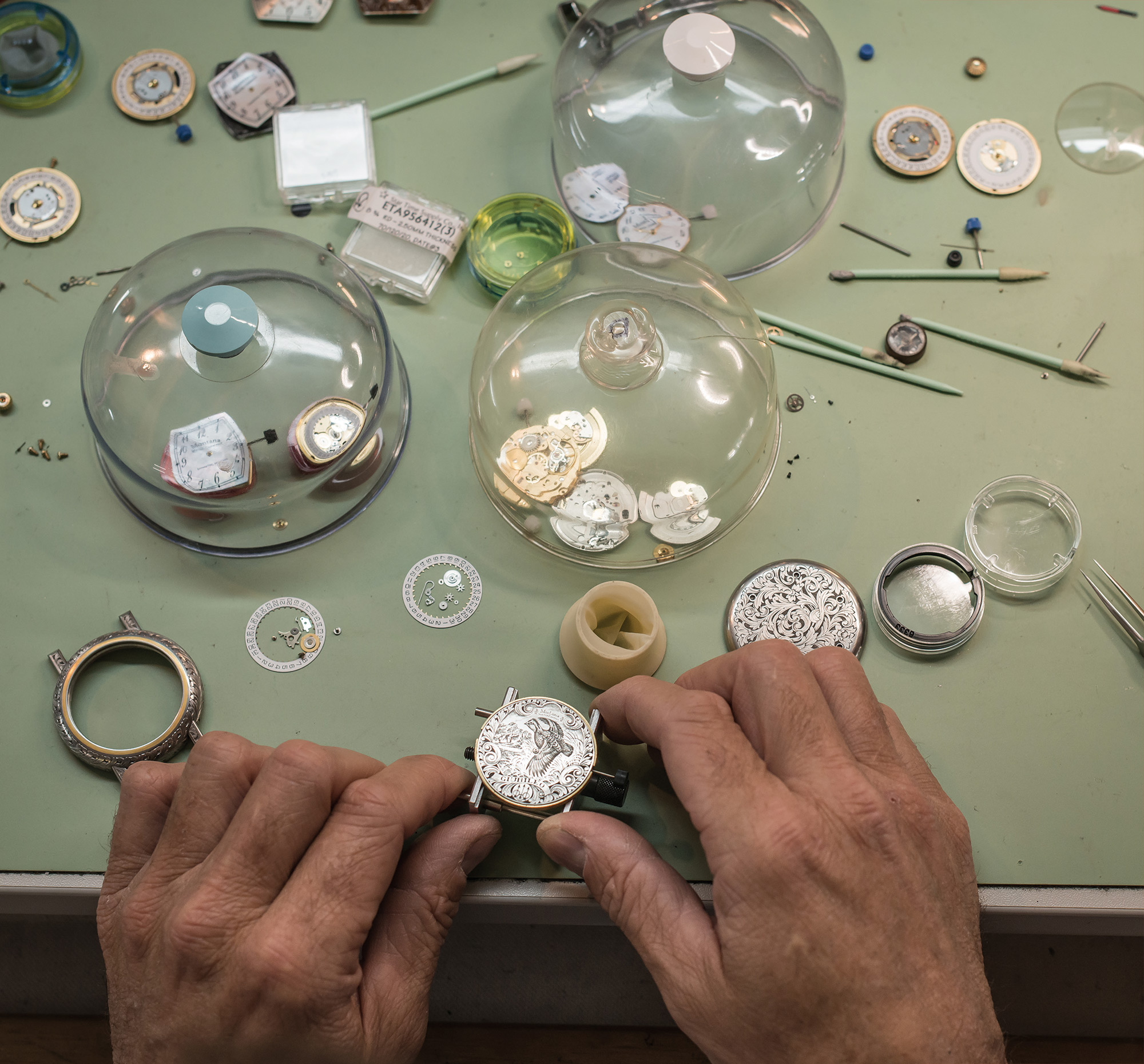
29 Jul The Art of Time: Montana Watch Company
THE MEASURE OF TIME, WHETHER INVENTED or merely harnessed for efficiency, has been with us from the start. Early man used the stars, the changing seasons and the setting sun to tell him when to move, when to plant and when to feast. Then came the sundial, the hourglass and the water clock. From there, the village bell tower told its residents when to pray and when to eat. But it wasn’t until 1714, when the British Parliament offered a cash reward to anyone who could invent an accurate clock for navigation, that a dependable and portable clock emerged.
Nearly 200 years later, a pocket watch was tucked into every man’s vest. But during World War I, pilots didn’t have that extra second to reach for their pocket watches. Ever after, watches and wrists went together like chocolate and peanut butter.
Enter the Montana Watch Company.
It is with those centuries of tradition in mind that Jeffrey Nashan, owner and founder of the Montana Watch Company and a connoisseur of horology, creates individualized, one-of-a-kind timepieces. Nashan’s firm is also one of only a few companies that wholly manufactures its watches in-house.
“I’m part of a movement to rekindle the watch industry,” he says, sitting in his Livingston studio. In front of him an array of tiny parts and delicate instruments lay scattered across his work area. Small glass cloches protect precision parts from the dusty, dry Montana air. “For a while America was very innovative [in watchmaking], but once they figured out how to mass produce the parts, it disappeared.”
The Montana Watch Company’s pieces are the farthest thing possible from mass produced. They only make 100 watches a year. No more. This way Nashan can handcraft each timepiece, working with his clients to find just the right images, materials and styles.
“We offer people the chance to express their individuality,” he says. “My clients want to create an heirloom. It has to be something that expresses their unique character, something that can only belong to them.”
Nashan started out restoring and repairing vintage watches. He’d go into thrift shops and pick up pieces that he liked.
“Livingston, because of the railroad, has tons of vintage watches,” he says, pulling out a box of old-timey watches, filled with a collection of stray pieces he’s picked up along the way. It’s his inspiration box. He reaches in and takes one out at random, glances at it and puts it back. Then he takes out an 18-karat gold engraved pocket watch with a back that opens. “That’s my great-grandfather’s watch. And he was a character.”
The watch could’ve only belonged to someone strong enough to be comfortable with such an intricate design.
“He was a lawyer and a politician,” he says, holding the round timepiece in the palm of his hand. “He got Jack Daniels back on the market after Prohibition.”
But it also made Nashan realize that the watch was the only piece of jewelry a man wore. And he wanted to give other people the kind of feeling his great-grandfather’s watch gave him — a sense of history.
“My first goal was to make Western watches,” he says. “We did a few engraved watches and we sold them. But I knew it wasn’t right. In the same way the light bulb went on in my head about watchmaking, it went on again for me in individualized watch manufacturing.”
Then he started looking for leather craftsmen, engravers and jewelers to help him get his vision across. He began by making a small batch of watches but it was only a sideline in his vintage repair and restoration store.
When he discovered Bulino engraving through one of his artisans, it was a moment of revelation.
Bulino engraving is a photorealistic, fine art style that uses minuscule dots and lines, perfected by Christian DeCamillis.
“I take an 8-by-10 photo and put that image on something the size of a postage stamp, with all the details,” DeCamillis says. “There’s nothing fast about the process. I’m cutting one line at a time, and there are hundreds of thousands of lines and dots on a watch face.”
DeCamillis, one of two or three engravers Nashan works with, started out as a goldsmith but fell in love with engraving.
“It’s been great working with Jeff,” he says. “I engrave animals, portraits, we do a lot of people’s dogs, hunting and fishing scenes. We also do game birds and the whole scene with birds and dogs. We basically do anything that people want.”
Much of DeCamillis’ work came from engraving vintage guns and knives, so when he got the opportunity to work on something as delicate as a timepiece, he went for it. This style of engraving is what was used to create bank notes before production went digital.
“It’s really an art form,” DeCamillis says. “It’s different from drawing. I taught engraving and actually went to Italy to learn this style. It’s not two-dimensional, it’s [nearly] three-dimensional. Even though some of the lines aren’t visible to the naked eye there’s a lot of relief on the surface.”
After Nashan began bringing in jewelers, engravers and leathersmiths, he took another leap of faith.
“I realized that my job was to take my style and work with artists and artisans to collaborate,” Nashan says. “I moved away from the traditional designs.”
Soon artists like John Banovich and Seth Minkin offered to team up on watch- face designs, a step that meant cross-pollinating clients with artists. In this way art collectors could carry their art on their wrists.
“What’s great about our collaboration is that Jeff is a watch guy who loves art; I’m an artist that collects watches,” artist Seth Minkin says. “It’s a compelling crossover. The translation is from a huge, colorful, crazy painting to a monochromatic watch face, and it’s very cool how they do it.”
Minkin’s paintings are complicated and large. His sardine pieces are lush with movement, push and swirl. Each canvas is packed with political undertones: Are we the sardines or are the sardines us? The shimmer and shine within Minkin’s work speaks to the nature of art and conveys a sense of our place in the world.
“I’ve had several clients request watches,” Minkin says. “In a couple of cases they used the images they commissioned, like an American buffalo on a square watch, and one with Balinese mythological creatures.”
Minkin might not have approached those subjects if not for his commission work.
“I relish those commissions because that’s the challenge,” he says. “Every image should evoke something and should take you somewhere emotionally. It should speak to you. And that’s what Jeff does. There are all kinds of jewelry in this world but it doesn’t grab you the way Montana Watch Company watches do. I’m looking forward to continue working with him.”
For Minkin, he found the sardine paintings to be a fantastic fit with the face of the watch.
“I saw the square face and I thought it would look like a can of sardines,” he says. “It’s so hip and kind of rock ‘n roll. These watches are beautiful and so to inject some humor in a very luxurious way is a chic pairing. There’s a lot gained in the translation. You could say what’s lost are all the colors, the size and the impact, but there’s a very interesting interpretation. I love it.”
Nashan found his niche in the market by creating a select number of watches for a limited number of clients, while working with some of the best artists and artisans in the country. Every step of the way he followed his passion and got closer and closer to his ultimate goal.
“And I loved working with these people,” he says. “I’m the hub between all these creative folks. I’m really fulfilled doing that. After 16 years, I feel like I’m reaching a peak.”
Collaboration takes time, and the process can go as long as six months, although that’s highly unusual.
“Once I have everything in front of me I can build a watch in a week,” Nashan says, putting down his jeweler’s double-lensed optical glasses. “I do have some pieces that I pick up and then put down again. Everything needs to be just right and I won’t call something finished until it’s perfect.”
Each watch comes with a lifetime warranty, with a stipulation that every five years the watch is returned to Nashan to be taken apart, cleaned and put back together.
And although Nashan won’t talk about specific clients, he does say they include two presidents, two Supreme Court justices, television celebrities, movie actors, race car drivers and sports team owners.
“Most of them have ties to Montana,” Nashan says. “And we do have a strong relationship with our clients.”
- A detailed drawing and portfolio are just some of the collateral involved in a collaboration with John Banovich for a mutual client.
- A detailed drawing and portfolio are just some of the collateral involved in a collaboration with John Banovich for a mutual client.
- The interior of The Montana Watch Company’s showroom in Livingston, Montana.
- The completed Model 1920; hand engraved, with gold inlay.
- A finished one-of-a-kind timepiece incorporating the fine art of painter Seth B. Minkin.
- For over 16 years Jeffrey Nashan has created custom timepieces for a distinctive clientele from across the globe.
- An American-made custom watch box and roll accompany this unique timepiece to its new owner, a collector in northern Italy.
- Nashan busy at his workbench assembling a timepiece.
- Nashan’s great-grandfather’s custom engraved pocket watch that inspired him to engrave watches.




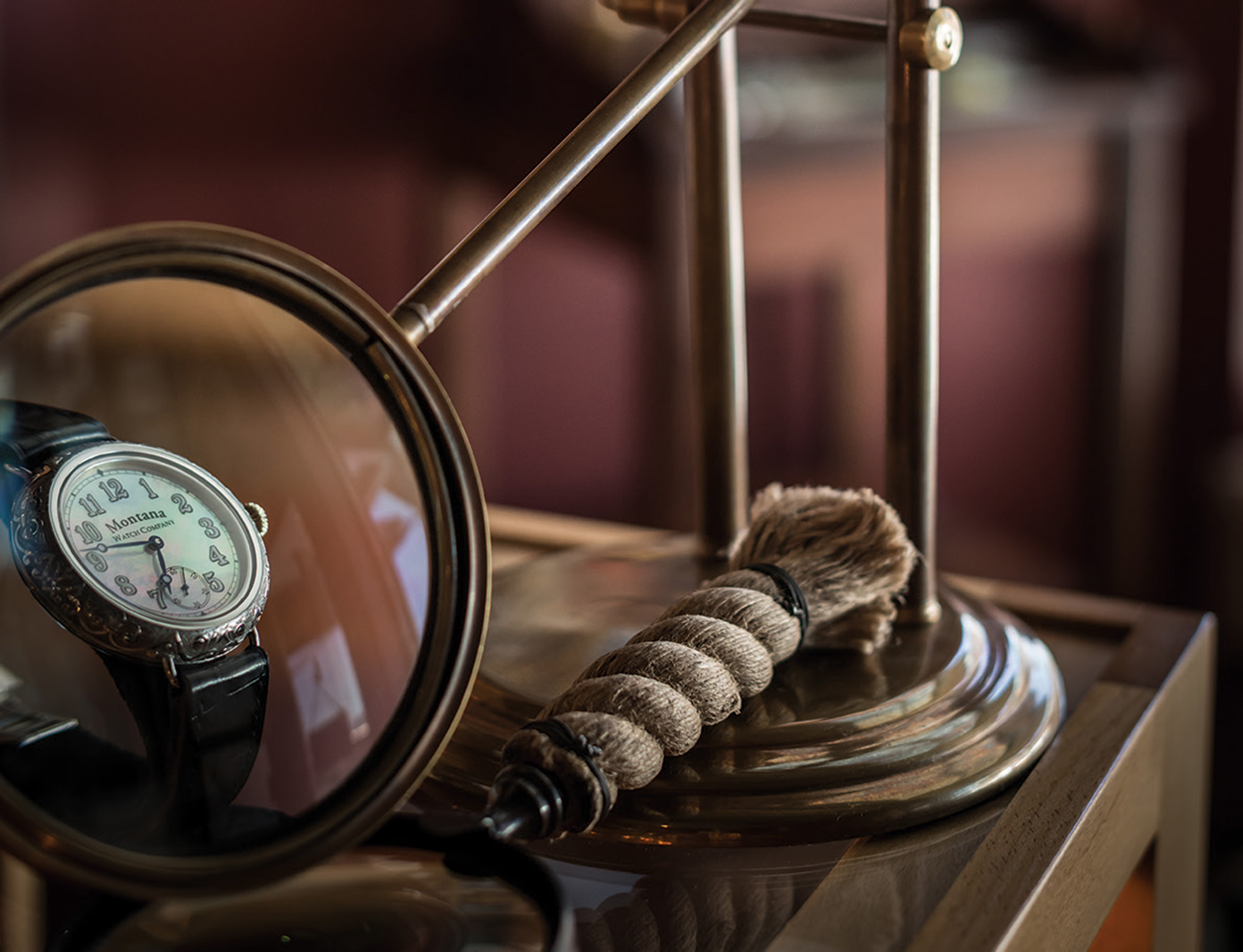
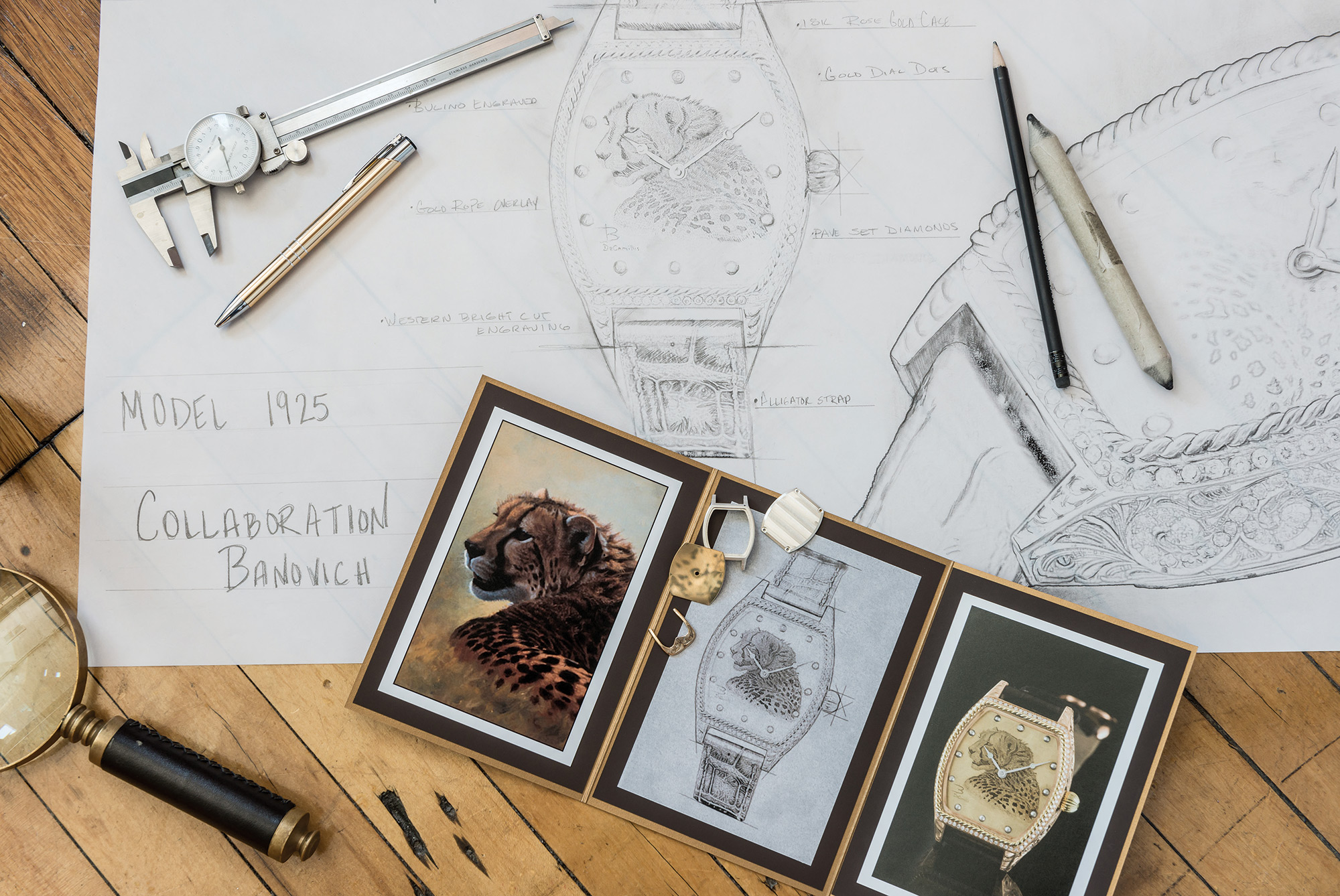
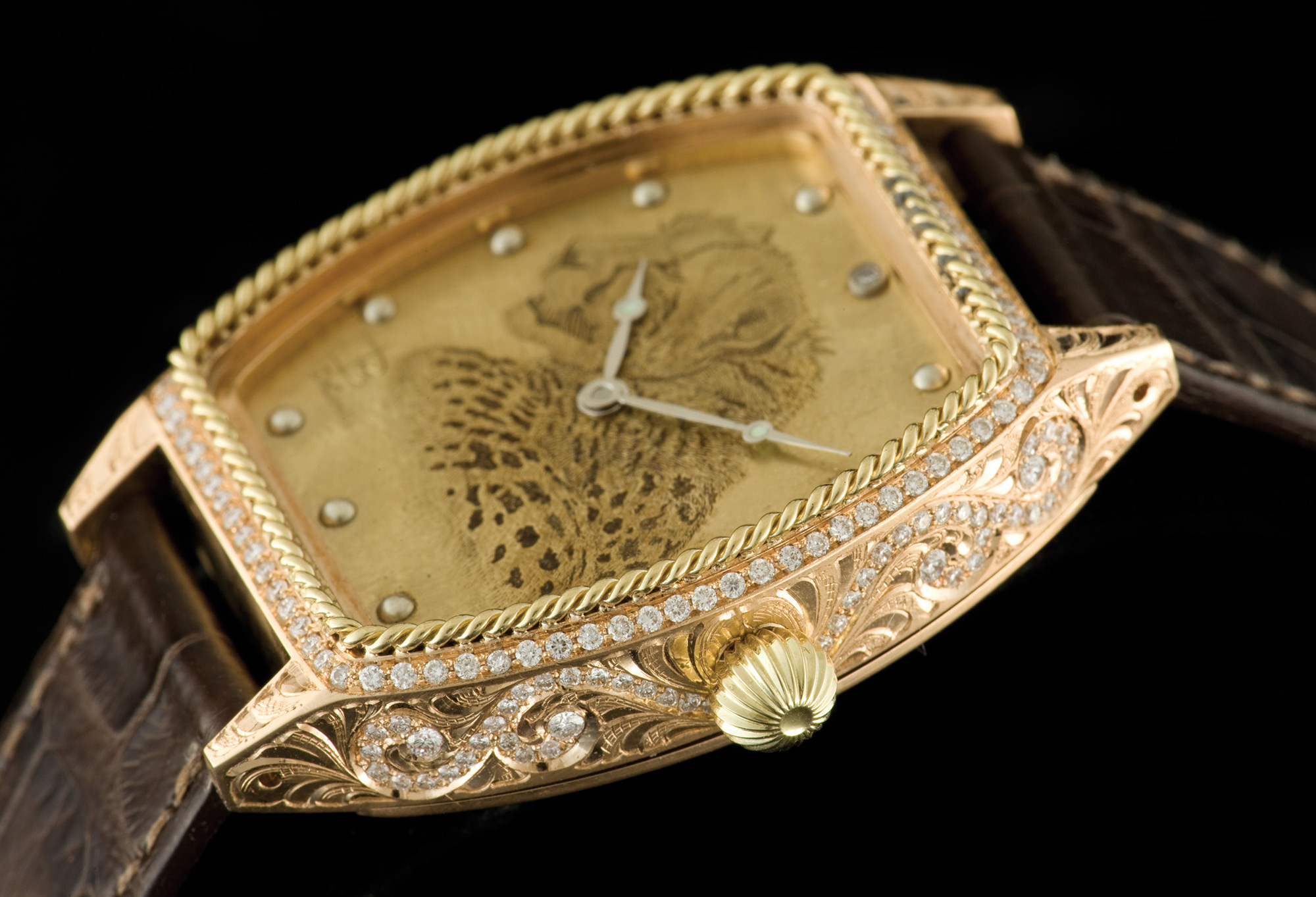

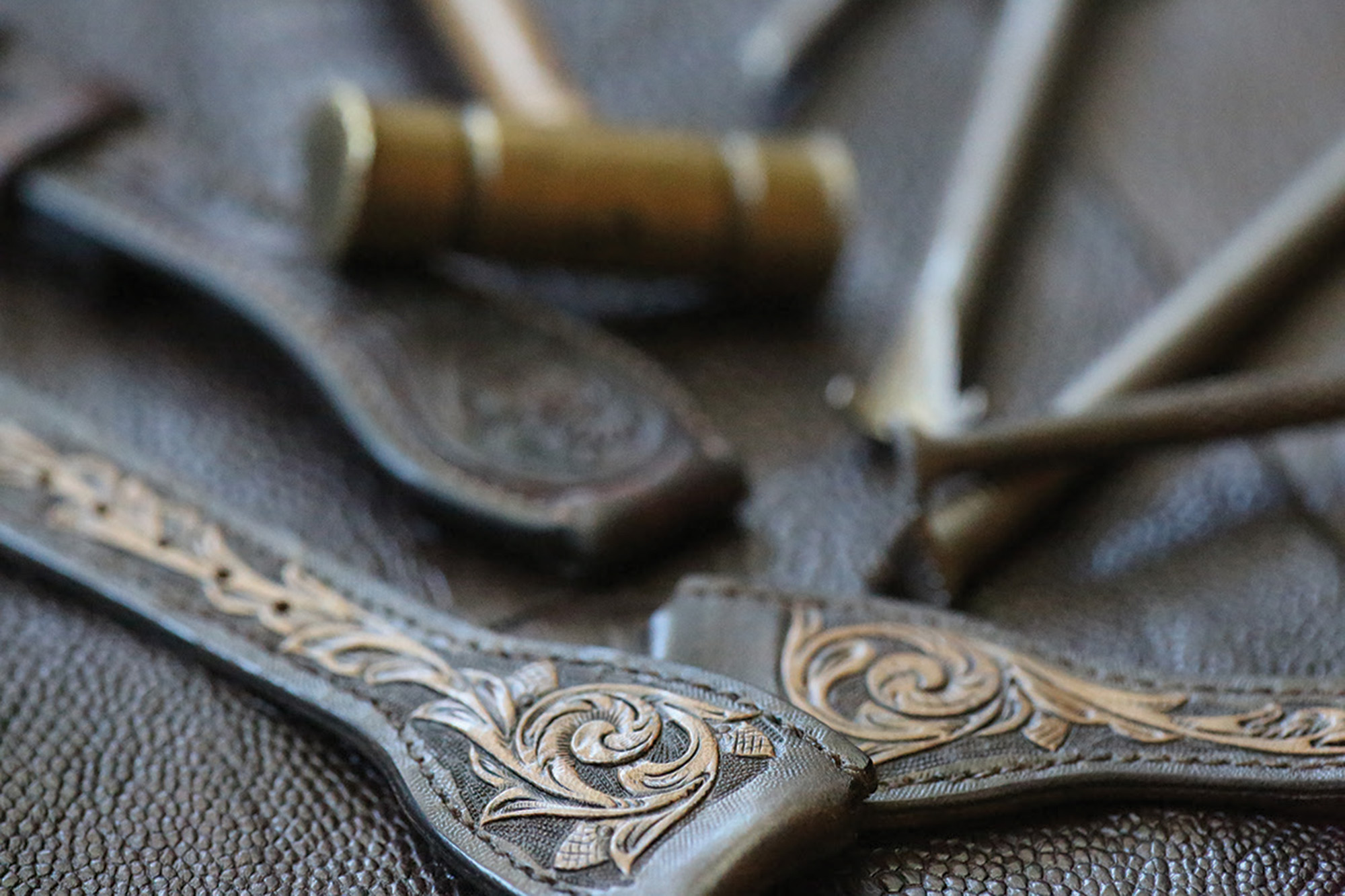


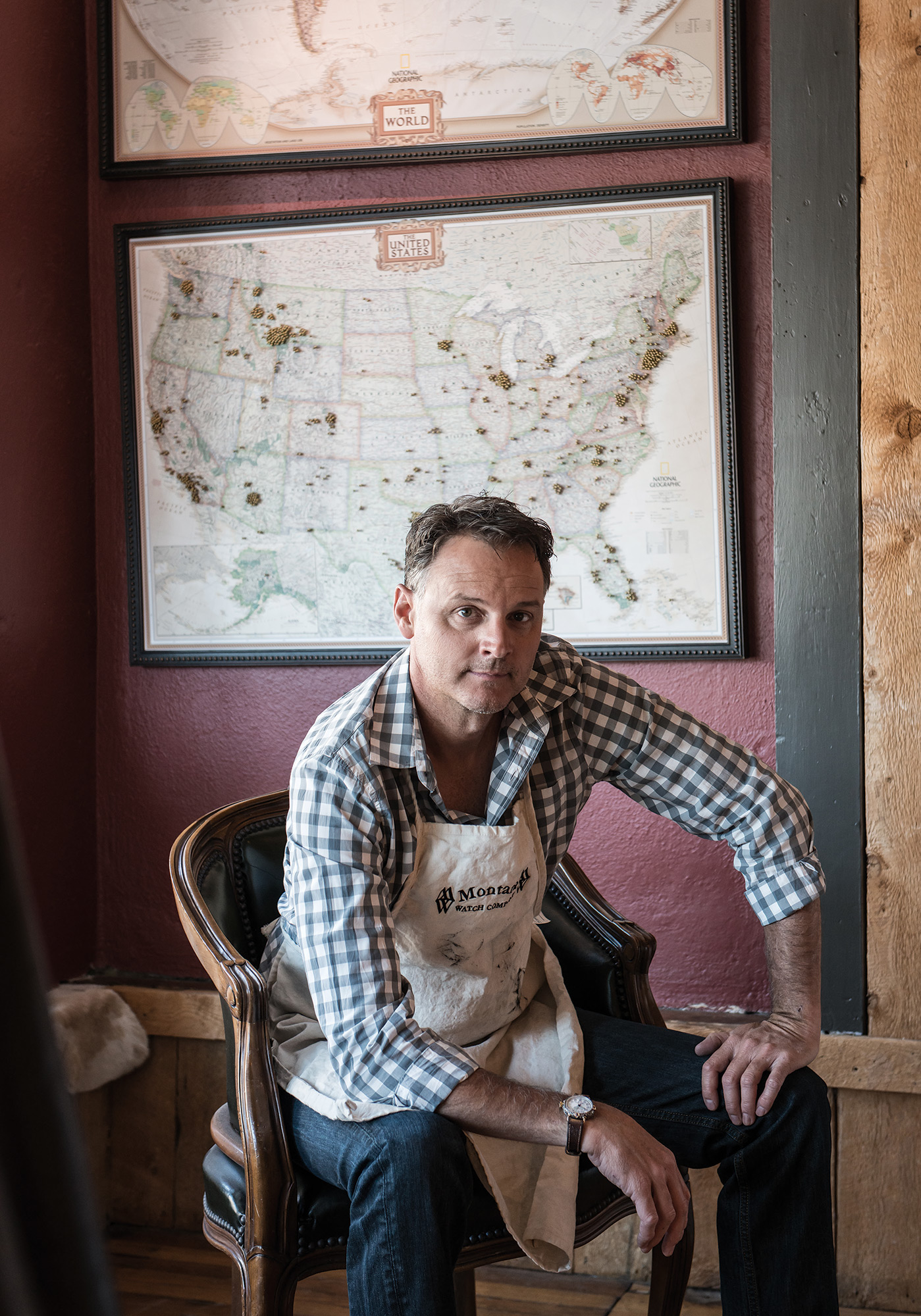
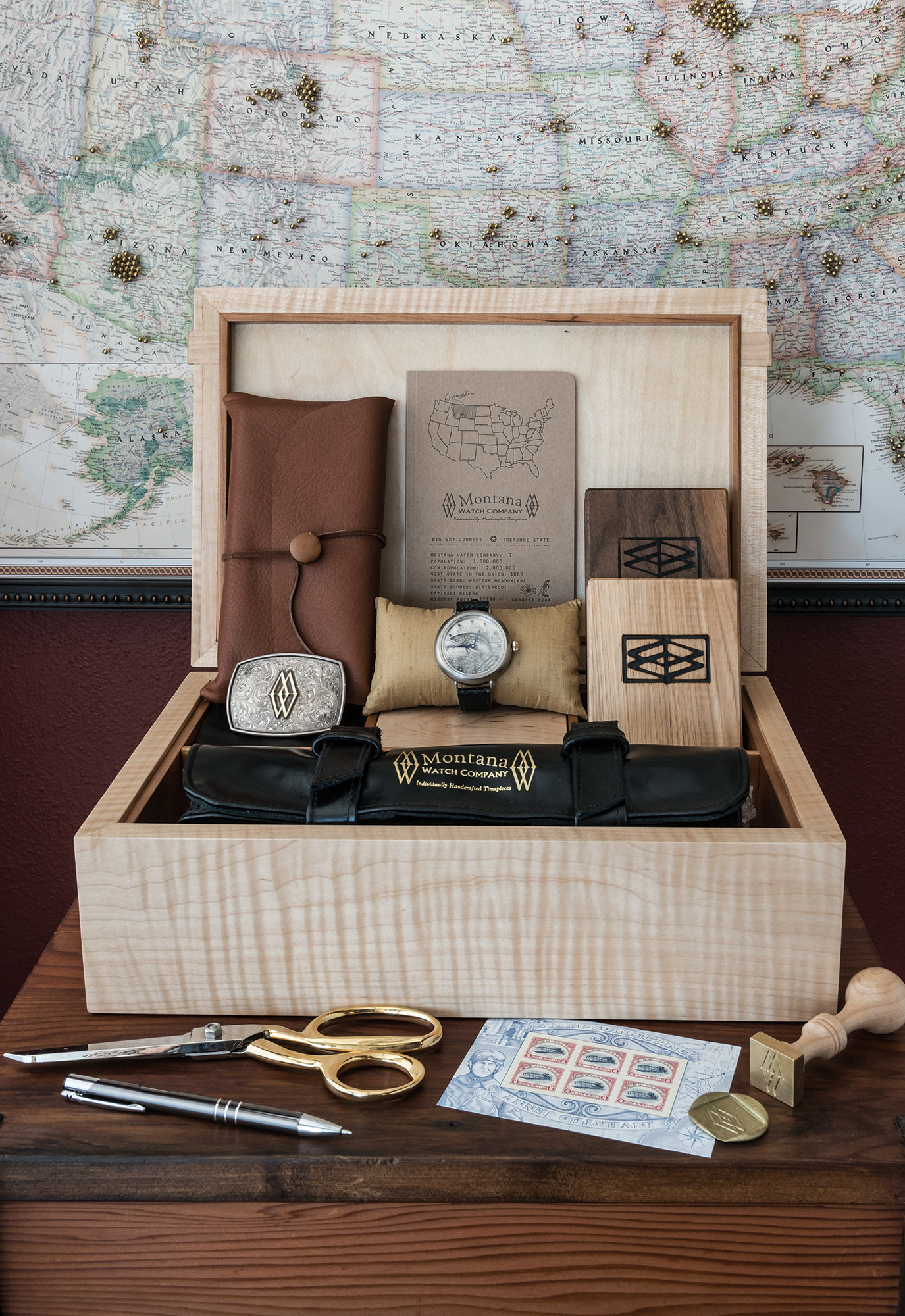
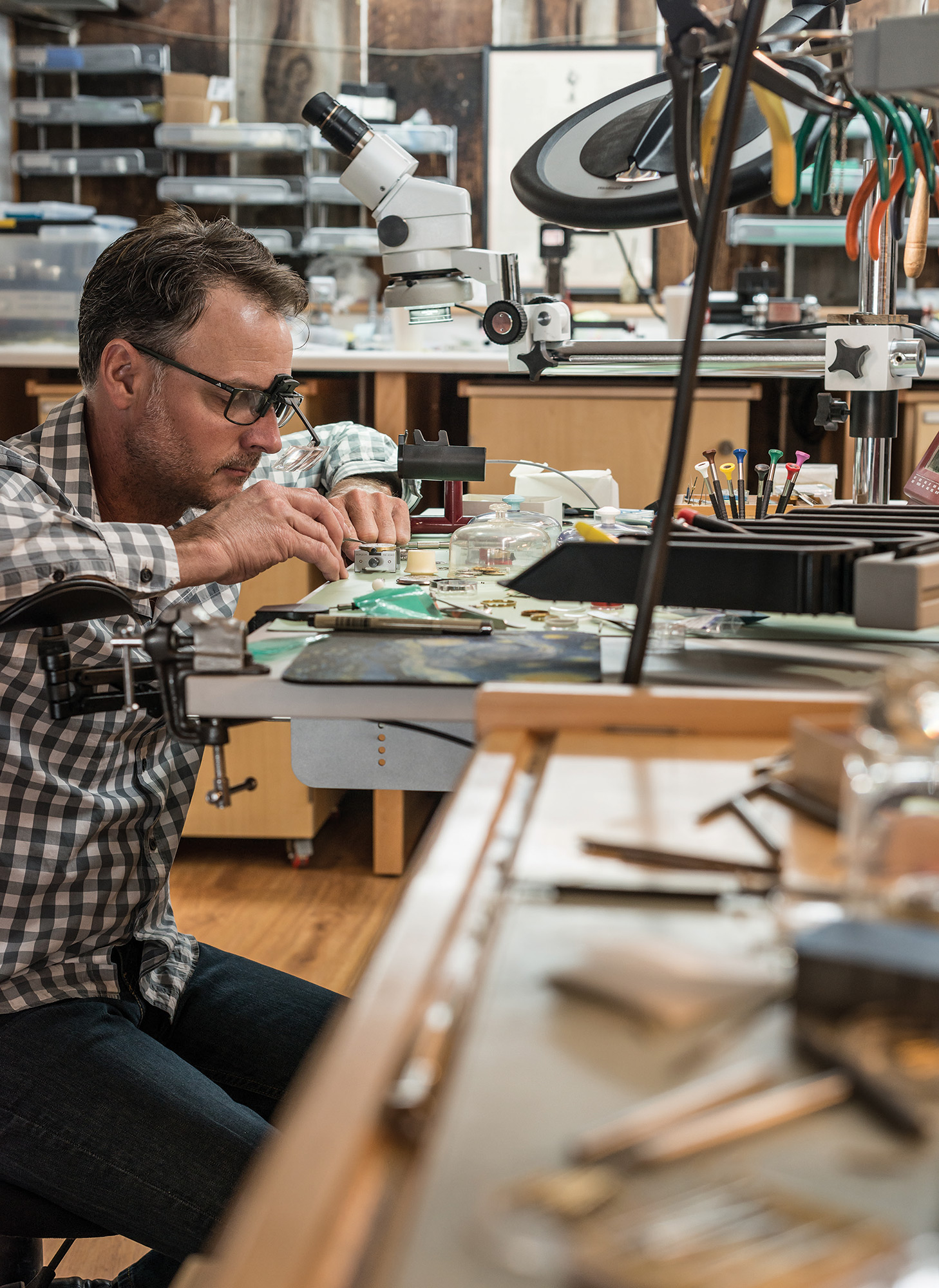
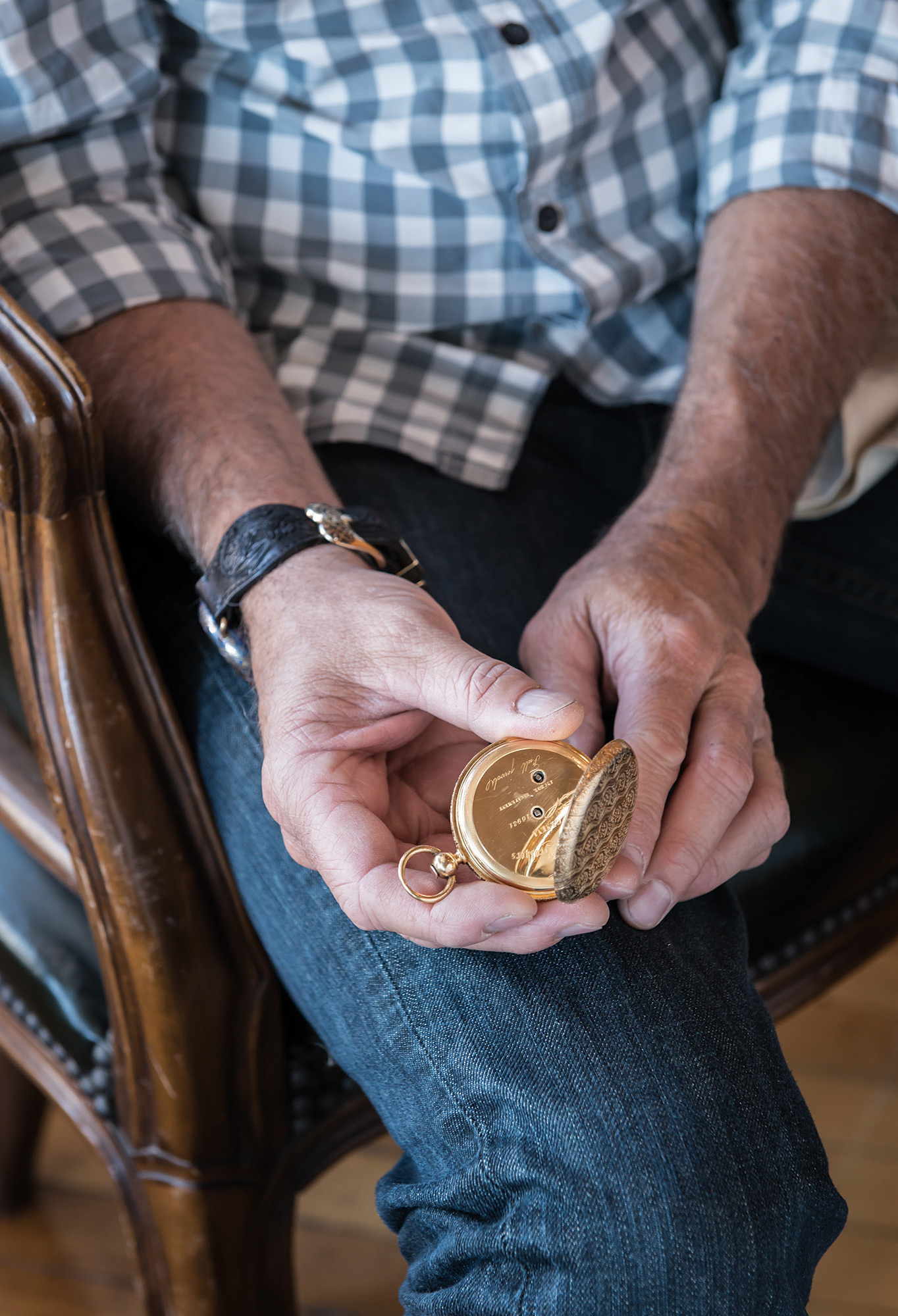
No Comments